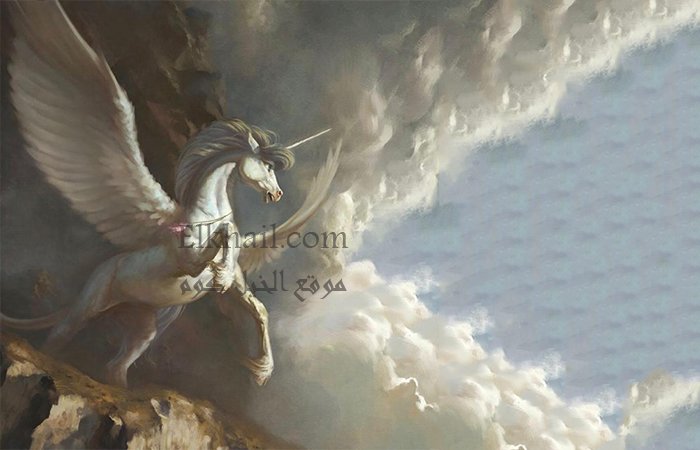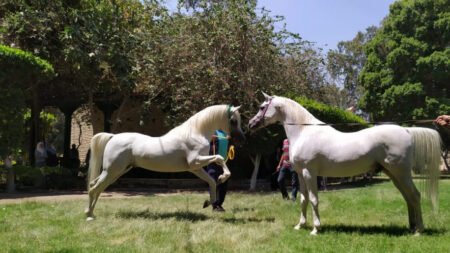The 5 main factions of the Arabian horse include: “Saqlawiyat, Al-Jadraniyat, Al-Shweimat, Al-Khailat, and Al-Abyan.”
“The era of the Prophet David (PBUH)”, thus the narratives of a number of writers concerned with horses chronicled the lineages of the purebred Arabian horse, saying: The Prophet Solomon inherited from his father David (PBUH) a large number of horses.
The Arab was keen on the pedigree of horses, his keenness on his lineage. Just as there were the forefathers who verbally transmitted the lineage of each person, there were those who master the genealogies of horses and attributed them to their fathers and mothers, so that we find entire books that are limited to that, like what Ibn al-Kalbi did in his book “Genealogy”. Horses, ”and Al-Ghandjani in his book“ The Names of Arab Horses, Their Genealogies and Their Riders Male. ”The owners of thoroughbred horses have always boasted that their mares come from the offspring of the rider’s excess, crooked, later or otherwise.
And he narrates on the authority of Ibn Abbas (may God be pleased with them both) who said: “The first thing that spread among the Arabs from those horses was that some of the people of Oman came to Sulayman bin Dawood, peace be upon him, after his marriage to Qais, the Queen of Sheba, and they asked him what they needed from the matter of their religion and world. Until they spent what they wanted, and were deluded; They said: O Prophet of God! Our country is vast, and we have run out of supplies. So we passed out food that would reach us to our country, so Solomon paid them a horse from David’s horse.

And he adds, he said: “This has increased you! If you go down, carry a man to him and give him a (spear) and wood and show your fire, for you will not collect your wood and let your fire come to you until he comes to you to hunt. So he made the people not go down a house unless they carried on their horse a man with his steadfast hand, and they stung and watered their fire. They only stay a little while until their owner brings them a catch of antelopes, reds and cows, and he brings them what suffices them.
Moreover, they were pleased with him, so the Azdites said: Our Persians have no name except for the rider’s increase. That was the first mare that spread to the Arabs from those horses. The origin of the Arab stallions is his product.
Ibn al-Kalbi narrates in the horse genealogy: “The first mare spread in the Arabs increased the rider to the Azad. When Bakr bin Wael heard about him, they came to the sons of Thalib, and they interrogated them, and it resulted from the hagis of diamonds, and it was better than Al-Hajis, and its descendants were crooked, notable, raven, and later, and a torrent.
Under the purebred Arabian horse bloodline comes five main factions: the Saqlawiyat, the Jardaniyat, the Shuyimat, the Kaheilat, and the Abyan. ”This belief continued until the end of the nineteenth century and the beginning of the twentieth century, when some orientalists interested in Arab horses divided their breeds into three large types, including 20 A major family branching out from 240 other species, but those interested in preserving the purebred Arabian horse trace its origins on the mother’s side to 23 species, mostly belonging to three types: “Al-Kahilan, Al-Saqlawi and Al-Manki”.
“Kahilan”, which is characterized by its large size and the magnitude of its muscles, and its females appear to have a beautiful male body, and the khailan is characterized by their large size and the magnitude of their muscles, and their beauty is masculine, even their females appear to have a beautiful male appearance, and it is one of the best Arabian horses, and the predominant color is brown. It has many branches, including: Al-Hamdani, Al-Hadyan, Al-Shuwaiman, Al-Wudanan, Al-Agouz, Al-Hifi, Al-Jalabi, Al-Roudan, and Al-Karushan, and Al-Kahilan is generally considered the best Arabian horse for riding.
Al-Saqlawy, who is distinguished by his beauty that takes a feminine character even among males, is smaller in size than Al-Kahilan, and is distinguished from him by his beautiful head and broad forehead with a clear dip in the side view of the nose, and the most important branches of the mother’s side are: “Saqlawi, Al-Jadrani, Al-Abyan, and Adhaman, Al-Rishhan, Al-Tuwaisan, Al-Jadrani Bin Sudan, and Al-Shefi. ”Al-Saqlawy is also generally considered the best Arabian horse for the purposes of parades and celebrations.
While the “Maanaki” is the best for running and racing purposes, it is distinguished by its fluffy body, long head and neck, huge in size, and its face differs from other Arab horses in its many angles, rough nostrils and small eyes.
“Al-Maanaki” preserves its originality as long as it remains pure without mixing with other strains, and that any mixing at any stage of its development leads to a deterioration of its value and the disappearance of its originality. Much of this strain has entered Europe, headed by the famous Arabian horse “Arab Darley”, Which is the ancestor of the breed known as “Thorbird”.








